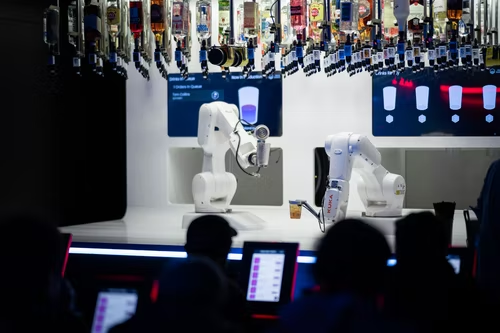
15 Mar 2022 POSTED BY DIYA Robotics
Why do you think Metaverse is dominated by robotics?
The Metaverse is a network of 3D virtual worlds focused on social connection. Often in science fiction and futuristic writing, it is described as a single, universal virtual world that is facilitated by using virtual reality, brain-computer interfaces (BCI), and augmented reality headsets.
Mark Zuckerberg, the CEO of Facebook, recently announced the grand entrance of the Metaverse, a parallel universe of a virtual world. Any individual with smart glasses or virtual reality headsets can visit a virtual or computer-generated universe via metaverse technology.

The 3D virtual environment features different robotics applications with different kinds of robots. Due to their smart functionality, robotics in the Metaverse is quickly becoming popular. Here is how Metaverse technology is boosting the popularity of robotics applications.
1. Training through robotic applications
Unity Simulation Pro and Unity SystemGraph, the platform for creating games and other 3D content, have recently launched robotic design and training to metaverse in order to improve the modelling, testing, and training of complex systems through artificial intelligence.
Robots are built from the ground up to deliver distributed rendering, enabling multiple graphics processing units (GPUs) to render the same project or simulation environment simultaneously, either locally or in a private cloud. This means multiple robots with tens, hundreds or even thousands of sensors can be simulated faster than in real-time inside the Metaverse.
2. Robotic construction of the metaverse
The construction of robots plays a crucial role in the building of the metaverse. Robots are designed as players in the metaverse. Developing a thin, replaceable skin that allows robots to "feel" could pave the way for the metaverse. In a joint effort made by Meta and Carnegie Mellon University, the skin is made from a rubbery plastic with magnetic particles embedded in it. It is calibrated using artificial intelligence to feel the sense of touch.
In contact with a surface, skin deforms the plastic, affecting the magnetic field generated by the particles embedded in it. The AI monitors these changes, converting them into a force and thereby providing a sense of touch.
The technology, known as ReSkin, can measure a touch as light as 0.1 Newtons of force with an accuracy of 1 millimetre. It can also monitor changes up to 400 times a second. As opposed to earlier skin systems, ReSkin is less expensive because it does not require built-in electronics to monitor touch sensitivity. In light of the fact that robotics is more involved in the metaverse, the future of metaverse may be influenced by robots and robotics.
In conclusion, new metaverse technologies will be dominated by robotics. If you are a smart parent who wishes to indulge your progeny in a better path, then there is a way for you to do so. Here we have an appropriate online learning platform, like DIYA robotics, which offers students the capacity to learn prodigious future-ready skills in a simple, engaging manner! The projects that they complete will be shown to you as parents so you can see just how far they've come!
Are you concerned about your child's future? Enrol with us at www.diyalabs.my and avail of a free session worth 750RM today!